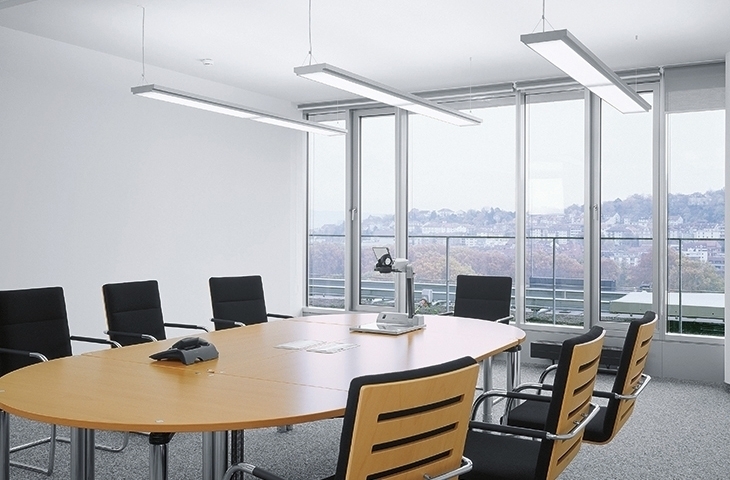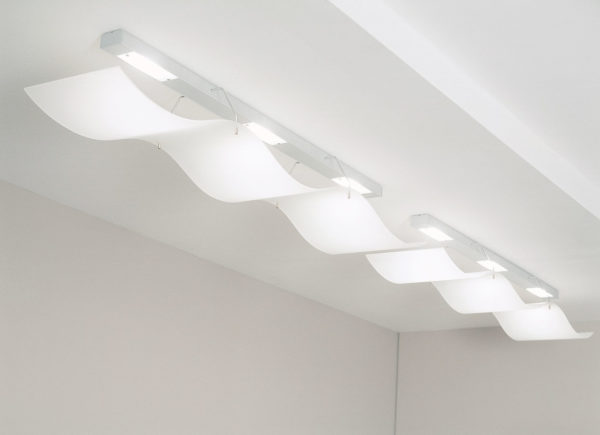
Office Lighting Ideas and Tips | Best Office Lights and Lamps.
Offices may differ in design, but proper lighting is a common thing every office owner should consider. If a workplace does not have a lot of natural light, then artificial lights are even more important. Today, modern offices have taken a step forward to introduce modern lighting techniques that favor all aspects of office space. With modern office lighting fixtures, you are able to bend, pivot, adjust, dim and brighten your way to the perfect working environment.
Lighting Fixtures for the Workplace
Offices are more and more reliant upon computers and visually processed information. For this reason, office lights have never been more relevant or more important. Good lighting at the workplace will make your staff feel happier and healthier, cutting down on leaves and costly down time. Studies show that bright, airy offices help to motivate staff, and increase productivity. Good lighting also makes for a safer office, where potential hazards can easily be seen and avoided.
Several different functions need to be taken into consideration when assessing the lighting in an office. Not only does illumination support visual perception, but it also has emotional and biological effects. Since initial visual perception is achieved by illumination, ceiling fixtures should be chosen individually according to the room condition. Floor lamps and table lights can be used as well to intensify the lighting, particularly in areas where visual display equipment is situated.

Ceiling Light Fixtures
Since commercial office light fixtures are typically installed either in or on the ceiling, the ceiling construction in the office has a big impact on the types of fixtures that can be used. For example, for a offices with drywall ceilings LED panels and recessed fixtures make the easy choice, bur for open ceilings pendant mounted fixtures are a better option. Dropped ceiling lights are usually either recessed into the grid, mounted on the panels, or suspended below panels.
LED panels
LED panel lights one of best lighting options for indoor settings. There are four kinds of standard installation: LED panels, recessed, suspended, mounted, and build-in. LED panels can be mounted to the walls or hanged on the roof or mounted on the surface of other objects, which makes it suitable for a wide range of applications.
Suspended ceiling light fittings
Suspended linear lights are a great fit for offices with higher ceilings. They offer direct, indirect or dual light distribution. Another type of suspended lights are office pendant lighting, that works well above individual desks or in clusters above a conference table.

Desk Lamps
Society may be moving away from paper toward digital records, but desk lamps continue to have a role in the workplace or in the home even if you’re rarely hunched over your desk, staring at a pile of paper these days. You need a lamp that can deliver the right amount of light exactly where you need it to work comfortably, prevent headaches and eyestrain, and boost your energy. While most homes and offices come with overhead lighting, and you may even be lucky enough to have your desk by a window, a desk lamp can deliver focused lighting just where you need it.
The best desk lamps take full advantage of LED lighting technology, creating lamps that are both stylish and energy efficient. The great quality of light you receive from LED makes these lamps enjoyable to use anytime you need a bit of extra light.
Floor Lamps
Floor lamps for home offices work to round out the decor of the room and provide a casual source of ambient illumination. Often placed in the corner of the room, these floor lamps bring contemporary style into a space that is typically only used as a work area. From energy efficient LED floor lamps to traditional arc lamps and designs with far-reaching adjustable arms, there’s a floor lamp fit for your office here.
Light Control System
Lighting control systems are designed to save energy in an office building by responding to how each area of the office is used. Adding a lighting control system into an office redesign or fit out means you can get the most out of any new lighting that has been installed in terms of performance and energy saving capabilities.
As well as making the most out of natural daylight, lighting control systems will help you to save money by regulating the lighting in different areas of your office. Areas that aren’t in constant use, such as corridors, toilets and meeting rooms, will benefit from a lighting control system as this will ensure these areas are only lit when they are in use. Occupancy control sensors ensure that the areas are lit when in use and that lights are switched off when they are not needed.
Lighting control systems add a level of flexibility to lighting that is vital in modern offices. Dimmer switches can be installed to control light levels in meeting rooms where projectors are used.
Blinds and window dressings can also be considered as lighting control systems. Perforated blinds maintain the view outside of a window whilst redirecting sunlight onto the ceiling. This makes them a good choice when redesigning an office.

What to Look for in an Office Lighting System
Adequate lighting system must possess certain well defined characteristics:
Sufficient Quality
Choosing the right level of light in the workplace can prevent workers becoming tired and losing concentration on their tasks. Illumination, measured in Lux, should be at a minimum of 500 for computer workstation brightness and generally speaking, an increase in Lux boosts visual performance and positively influences information processing.
Sufficient Quantity
The number of fixtures needed to light a space is highly dependent on the fixture type, the mounting height and the finishes in the room. As a rule of thumb, general lighting can be achieved with one fixture every 8’ or so in a drop ceiling office. For linear pendant light fixtures, where the fixtures are typically installed in continuous rows, its more about selecting the right light source and configuration based on where the lights will be installed to reach the target light levels.
Brightness
Brightness of light means the light reflected from an object. It also controls contrast which affects seeing. The great contrast prevents seeing.
Intensity
The lighting system should provide the right degree of intensity. The light should be well spread over the workplace and should not cast shadows. The spreading of light should be uniform over the entire work surface.




